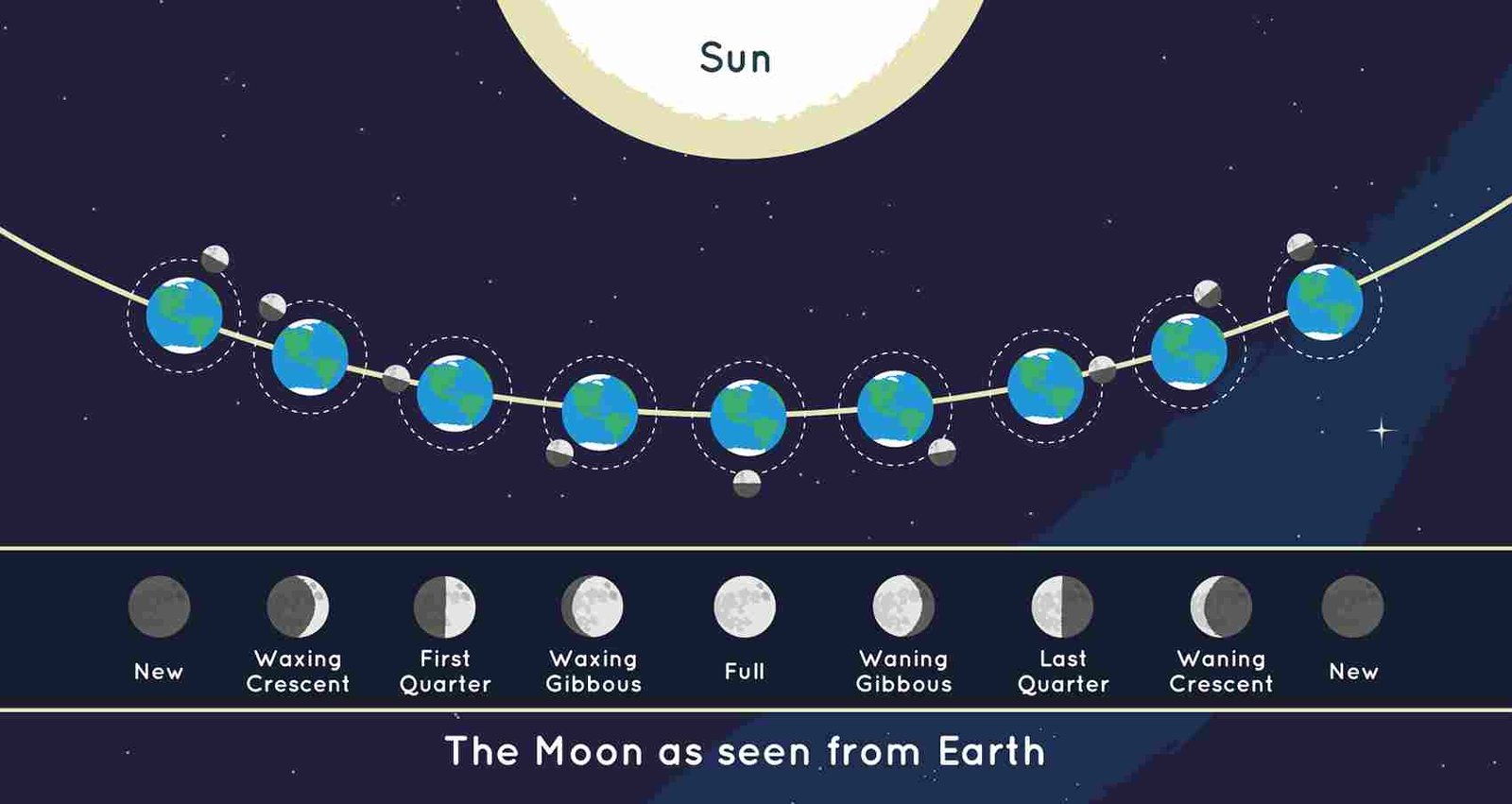The Science Behind the Phases of the Moon: How the Moon’s Orbit Affects Its Appearance
The moon, the Earth’s natural satellite, has captivated human imagination for millennia. Its phases – the gradual changes in the moon’s appearance throughout its monthly orbit around the Earth – have been a source of fascination and inspiration for poets, artists, and scientists alike. Understanding the moon phases is not only an essential aspect of astronomy but also carries cultural and spiritual significance in various communities worldwide.
But what causes these phases, and why do they occur in a predictable cycle? The answer lies in the moon’s orbit around the Earth and the way its position relative to the sun changes over time.

The phases of the Moon as viewed looking southward from the Northern Hemisphere. Each phase would be rotated 180° if seen looking northward from the Southern Hemisphere. The upper part of the diagram is not to scale, as the Moon, the Earth, and the Moon’s orbit are all much smaller relative to the Earth’s orbit than what is shown here. Orion 8, CC BY-SA 3.0, via Wikimedia Commons
Details of Moon Phases
There are eight primary phases of the moon, each with its unique appearance and significance. These phases are:
- New Moon: The new moon occurs when the moon is positioned between the Earth and the sun, with its illuminated side facing away from us. It appears as a dark, shadowed disk in the sky.
- Waxing Crescent: The waxing crescent occurs when a small sliver of the illuminated side of the moon becomes visible on the right side of the darkened disk.
- First Quarter: The first quarter occurs when half of the illuminated side of the moon is visible, and the moon appears as a half-moon.
- Waxing Gibbous: The waxing gibbous phase occurs when most of the illuminated side of the moon is visible, and only a small sliver of the dark disk remains visible.
- Full Moon: The full moon occurs when the entire illuminated side of the moon is visible, and it appears as a bright, full disk in the sky.
- Waning Gibbous: The waning gibbous phase occurs when the illuminated side of the moon begins to shrink, with only a small sliver of the dark disk becoming visible.
- Third Quarter: The third quarter occurs when half of the illuminated side of the moon is visible, but on the opposite side from the first quarter, making the moon appear as a half-moon again.
- Waning Crescent: The waning crescent phase occurs when only a small sliver of the illuminated side of the moon is visible on the left side of the darkened disk.
Example:
An example of the significance of the moon phases is in the Chinese New Year celebrations. The start of the lunar new year is determined by the second new moon after the winter solstice, marking the beginning of the new lunar cycle. The celebrations begin on the first day of the new moon and continue until the full moon, with each phase symbolizing a different aspect of the celebration.
The Science Behind Moon Phases
Here are some details explaining the science behind the phases of the moon:
- Moon’s Orbit: The moon orbits the Earth once every 27.3 days, with one side always facing the Earth. As it moves around the Earth, the amount of sunlight it reflects changes, creating the different phases.
- Lunar Cycle: The lunar cycle begins with the new moon, when the moon is positioned between the Earth and the sun. At this point, the illuminated side of the moon is facing away from the Earth, and it appears as a dark disk in the sky. As the moon moves further away from the sun, more of its illuminated side becomes visible, leading to the waxing crescent, first quarter, waxing gibbous, and eventually the full moon.
- Lunar Eclipse: Occasionally, the Earth comes between the moon and the sun, causing a lunar eclipse. During a lunar eclipse, the Earth’s shadow falls on the moon, causing it to appear reddish-brown or coppery in color.
- Tides: The gravitational pull of the moon affects the tides on Earth, with the strongest tides occurring during the full and new moons.
- Distance: The moon’s distance from Earth also affects its appearance. When the moon is at its closest point to Earth (perigee), it appears larger and brighter in the sky, while at its farthest point (apogee), it appears smaller and dimmer.
Significance of Moon Phases
The phases of the moon have significant cultural and religious importance in various communities worldwide. For example, the Islamic calendar is based on the lunar cycle, and the sighting of the new moon marks the beginning of a new month. In Hinduism, the full moon is considered auspicious, and many festivals and rituals are timed to coincide with it. The moon’s phases also have spiritual significance in many traditions, with some practitioners using the energy of each phase for manifestation, meditation, or ritual work.
Conclusion
The phases of the moon have both scientific and cultural significance, providing a framework for astronomers to track its movements and a source of inspiration for artists and spiritual practitioners worldwide.
The phases of the moon are not just beautiful to observe; they also provide valuable insights into the complex interplay between the Earth, the moon, and the sun.
By understanding the science behind the moon’s phases, we can appreciate the wonder of the natural world and gain a deeper appreciation for the cultural and spiritual significance that the moon holds in various traditions.
Sources: PinterPandai, Primary Homework Help, Wikipedia (Inggris), Moon Phases, Moon Connection, NASA
Photo credit and description (main picture): this graphic shows the position of the Moon and the Sun during each of the Moon’s phases and the Moon as it appears from Earth during each phase. Not to scale. Credit: NASA/JPL-Caltech via Nasa
Planet Distance to Sun | How Far Are The Planets From The Sun?



